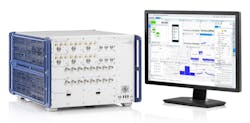Approaching an Inflection Point in 5G Device Testing
What you’ll learn:
- Evolution of cellular and device testing from 4G LTE to 5G cellular and device testing.
- Current 5G application test requirements.
The 5G wireless technology standard is one of the fastest and most robust technologies available to consumers. Slowly replacing 4G around the world, 5G is delivering higher peak data speeds, low latency, and better bandwidth with greater uniformity.
While 4G was designed for cellular phones, 5G boasts the flexibility to connect machines, objects, and devices—better representing the way we use connected devices today and replacing the need for more specialized technologies. Beyond accelerating global technology innovation, 5G introduces use cases in industrial IoT (i.e., machine-to-machine communications) and ultra-low latency (e.g., remote medical operations).
The evolution of 5G depends on the development of two other major technologies. The first, enhanced mobile broadband (eMBB), supports peak data rates for massive amounts of users on the move; it extends services enabled by 4G LTE to meet expanding technological needs more efficiently.
The second, ultra-reliable low-latency communications (URLLC), is a subset of the 5G network architecture that focuses on efficient data-transfer scheduling, shorter transmissions, and enabling overlapping transmissions. The network needs low-latency capabilities for emerging applications in virtual reality (VR) and augmented reality (AR) among others, and URLCC offers that robustness to accommodate.
The 3rd Generation Partnership Project (3GGP), an organization uniting telecommunications standard development organizations, offers a framework for achieving advances—such as accommodating higher frequencies—to enable technological development and guide seamless evolution through the 5G lifecycle.
Generational Change in Communication Technologies
When new mobile wireless technologies emerge, companies opt to invest in high-performance, general-purpose test equipment for early research and development. Then, as standards form, they migrate to lower-cost, purpose-built equipment to test accordingly. As far back as 2019, companies were setting themselves up for early-release 5G by purchasing general-purpose equipment, but many decided to stretch their 4G testing technology instead.
4G LTE and early 5G equipment have accommodated rapid expansion in global communications. However, the onslaught of low-latency applications (e.g., gaming, real-time streaming, video) is encouraging more and more providers (e.g., AT&T, Verizon, etc.) to upgrade to the standalone 5G core network.
Today, companies face the inflection point that inevitably arises when wireless technologies advance. Just as 4G evolved into early-release 5G, with new network architectures, 5G is going to start looking like early-release 6G. Existing equipment that might have been stretched from 4G isn’t going to cover the full spectrum of 5G testing.
Cellular and Device Testing Today
5G is unique in its requirements, so companies can’t rely on general-purpose test equipment that was used early on in 5G research and development, or radio communication testers that were initially designed for 4G/LTE. With new applications added in every release, it continues to evolve.
So, in addition to RF measurements and signaling tests, here are a few of the unique application testing requirements we see today, that will continue to evolve as we move toward 6G.
- IP throughput testing: Complex test scenarios help designers meet data rate expectations. Maximum throughput testing in 5G is more challenging today because of factors like new radio resources and more bandwidth.
- Audio and video quality: Voice over new radio (VoNR) audio quality and audio performance tests are required for maximum voice performance and better user experience. Voice-over-5G test systems must fulfill complex requirements and support codecs for VoNR, voice over LTE (VoLTE), and beyond.
- Battery life: With high-performance, high-throughput applications, 5G brings significant power-consumption challenges; yet users still expect extended battery life. Meeting those expectations requires analyzing battery consumption for different scenarios and use cases.
- IP security: Data and IP security are paramount in today’s highly connected world. Particularly for devices that manage or store sensitive data, it’s important for developers to focus on testing and identifying weak spots in their applications and mobile designs that might jeopardize IP connection security and/or fail to meet regulatory compliance requirements.
As the foundation for 5G becomes more stable and more 3GPP features are adopted and commercialized, there’s a greater need for purpose-built test equipment that’s able to handle any new standard, capability, or application introduced by 5G. Innovation adds complexity by increasing the number of features and changing the way base stations and phones interact with each other. Today, companies must integrate new testing techniques over (or in addition to) legacy techniques established for earlier generations.
For example, VoNR is a mandatory feature for the successful deployment of 5G standalone. The benefit of VoNR is vastly improved voice audio quality by using ultra-high-definition codecs.
Addressing this need, the CMX500 radio communication tester developed by Rohde & Schwarz is capable of testing 5G NR devices in both standalone and non-standalone (NSA), TDD, and FDD modes. The CMX500 supports all codecs required for VoNR audio quality testing such as AMR-NB, AMR-WB, EVS-NB, EVS-WB, EVS-SWB, and EVS-FB, including audio quality analysis (POLQA).
Capable of testing sub-6-GHz (FR1) and mmWave (FR2) frequency bands, the R&S CMX500 radio communication test solution enables a unified test environment for signaling and non-signaling testing through all stages of 5G device development cycle to production.
In addition, 5G VoNR also is playing an important role in emergency services. Emergency calls (E911) on 5G standalone networks will use VoNR. Critical to FCC requirements is the continued reliability of E911 voice calls as well as accurate determination of vertical and horizontal location in mobile devices. The R&S CMX500 radio communication tester supports E911 over VoNR along with associated location determination technologies such as A-GNSS and AML/ELS.
Looking Forward
Meeting the demands of the entire 5G technology cycle is no small feat. Luckily, the industry has seen this movie before. The evolution of 5G promises to be similar to the evolution of LTE. Toward the end of LTE’s life cycle, the industry saw technologies such as LTE-Advanced and LTE-Advanced Pro, which stretched test equipment and test systems for more bandwidth and capabilities.
The same will be true for 5G. Opening up bandwidth means separating LTE/FR1 and FR2 chains to enable better RF resource deployment and establishing support for multiple applications on a flexible basis. Radio communications testers, such as the R&S CMX500, can meet this challenge as a new test platform that supports legacy technologies (e.g., LTE), current technologies (e.g., 5G FR1, 5G FR2; NSA), and evolving technologies (e.g., 5G NR SA).

